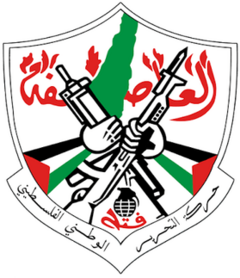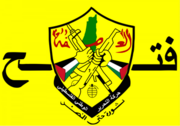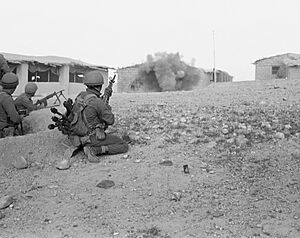Fatah facts for kids
Quick facts for kids
Fatah
فتح
|
|
|---|---|
 |
|
| Chairman | Mahmoud Abbas |
| Secretary-General | Jibril Rajoub |
| Vice Chairman | Mahmoud Aloul |
| Founders |
|
| Founded |
|
| Headquarters | Ramallah, West Bank |
| Youth wing | Fatah Youth |
| Paramilitary wing | al-Aqsa Martyrs' Brigades (until 2007) |
| Ideology |
|
| Political position | Centre-left to left-wing |
| National affiliation | Palestine Liberation Organization |
| European affiliation | Party of European Socialists (observer) |
| International affiliation |
|
| Colors | Yellow |
| Slogan |
|
| Palestinian Legislative Council |
45 / 132
|
| Flag | |
 |
|
| Fatah | |
|---|---|
| Headquarters | Ramallah, West Bank |
| Allies | State allies:
|
| Opponents | Non-state opponents:
Former state opponents
|
| Battles and wars |
|
Fatah (pronounced FAH-tuh or fuh-TAH) is a major Palestinian political party. Its full name is the Palestinian National Liberation Movement. It is a nationalist and social democratic group.
Fatah is the largest part of the Palestine Liberation Organization (PLO), which is a group of many Palestinian parties. It is also the second-largest party in the Palestinian Legislative Council (PLC). Mahmoud Abbas, who is the President of the Palestinian Authority, is the current leader of Fatah.
In the past, Fatah was very involved in revolutionary struggles. It has also had several armed groups. Yasser Arafat was a key founder and leader of Fatah until he passed away in 2004. After his death, different groups within Fatah started to disagree more often.
In the 2006 election for the PLC, Fatah lost its majority to Hamas. This led to a conflict between Fatah and Hamas. Fatah kept control of the Palestinian National Authority in the West Bank through its president. Fatah also helps manage Palestinian refugee camps.
Contents
What Does the Name Fatah Mean?
The full Arabic name of the movement is Ḥarakat al-Taḥrīr al-Waṭanī l-Filasṭīnī. This means "Palestinian National Liberation Movement".
From this long name, they created a shorter, reversed name: Fatḥ, which is usually written as Fatah in English. This word means "opening," "conquering," or "victory." The word fatḥ is also used in religious discussions to talk about the spread of Islam in early history. For example, Fatḥ al-Shām means "the conquering of the Levant".
Fatḥ is also the name of the 48th chapter of the Quran. This chapter talks about a peace treaty called the Treaty of Hudaybiyyah. After this treaty, many people joined Islam, making the Muslim side stronger. Yasser Arafat used this historical event to explain why he signed the Oslo Accords peace agreements with Israel.
Fatah's History
How Fatah Started

Fatah was started in 1959 by Palestinians living outside their homeland, mostly professionals working in places like Kuwait. Key founders included Salah Khalaf, Khalil al-Wazir, and Yasser Arafat. Many of them had studied in Cairo or Beirut and had been refugees in Gaza.
Yasser Arafat had previously led the General Union of Palestinian Students (GUPS) at Cairo University. Another co-founder, Khaled Yashruti, led GUPS in Beirut. When Fatah was founded, Arafat asked Mahmoud Abbas to join. These young Palestinian professionals from the Gulf region were the core of Fatah in its early days. Fatah believed that Palestinian Arabs should free themselves through their own actions.
The movement's name first appeared in Falastinuna, which was Fatah's official newspaper.
Fatah's Role from 1967 to 1993
Fatah became the most important group in Palestinian politics after the Six-Day War in 1967.
In 1967, Fatah joined the Palestine Liberation Organization (PLO). They were given 33 out of 105 seats in the PLO's main committee. In 1969, Fatah's Yasser Arafat became the Chairman of the PLO. The BBC reported that in 1969, Fatah carried out 2,432 attacks against Israel.
The Battle of Karameh
In 1968, Fatah and other Palestinian armed groups were attacked by the Israeli Defense Forces (IDF) in the Jordanian village of Karameh. This village was where Fatah had its headquarters and a Palestinian refugee camp. The name "Karameh" means "dignity" in Arabic, which made the battle very important to Arabs after their defeat in 1967.
Fatah leaders knew the attack was coming. Many other groups left the town, but Arafat ordered Fatah to stay. The Royal Jordanian Army agreed to support them if the fighting became intense.
On March 21, the IDF attacked Karameh with strong weapons. Fatah fought back, surprising the Israelis. As the fight grew, the Jordanian Army joined in, causing the Israelis to leave to avoid a bigger war. Many Fatah fighters and some Jordanian and Israeli soldiers died. Even with more Arab deaths, Fatah saw this as a victory because the Israeli army quickly left.
Black September Events
In the late 1960s, tensions grew between Palestinians and the Jordanian government. Palestinian armed groups had become very powerful in Jordan. After the Battle of Karameh, Fatah and other groups started to control daily life in Jordan. They set up roadblocks and collected illegal taxes.
In 1970, the Jordanian government decided to take back control. King Hussein declared martial law. By September 25, the Jordanian army had gained control. Arafat and Hussein agreed to a ceasefire. The Jordanian army caused many deaths among Palestinians, including civilians. Two thousand Fatah fighters moved into Syria and then to Lebanon, where they set up new headquarters.
A group of fighters who survived the Jordanian offensive formed the Black September Organization. This was a splinter group from Fatah. In November 1971, this group carried out an attack against the Jordanian prime minister.
In the 1960s and 1970s, Fatah trained many militant groups from different parts of the world. They also carried out attacks against Israeli targets in Europe and the Middle East. Some groups linked to Fatah, and some Fatah fighters, carried out plane hijackings and other attacks, often linked to groups like Black September. Fatah received weapons and training from the Soviet Union, China, and Algeria. In 1979, Fatah helped Uganda during the Uganda–Tanzania War.
Fatah's Role in Lebanon
The Palestinian cause had many supporters in Lebanon.
Yasser Arafat and Fatah played a big role in the Lebanese Civil War. Fatah joined forces with Lebanese communist and nationalist groups. However, Syrian President Hafez al-Assad feared losing influence in Lebanon. He sent his army to fight alongside Christian forces against the PLO.
In April 1975, Christian forces killed 26 Fatah trainees, which marked the start of the 15-year Lebanese civil war. Later that year, Christian groups attacked a Palestinian refugee camp called Karantina, killing many civilians. The PLO and their allies attacked the town of Damour in return, also killing many civilians. As the war continued, both sides used heavy weapons, and terrible acts were committed.
In 1976, Christian groups took control of the Tel al-Zaatar refugee camp after a long siege. Hundreds died in this event, also known as the Tel al-Zaatar massacre. Arafat and Abu Jihad felt responsible for not being able to rescue them.
PLO attacks against Israel from Lebanon increased in the late 1970s. One major attack happened on March 11, 1978, known as the Coastal Road massacre. Fatah fighters landed near a main road and attacked a bus, killing 37 civilians. In response, the IDF launched Operation Litani to take control of Southern Lebanon. The IDF succeeded, and Fatah moved north into Beirut.
Israel invaded Lebanon again in 1982. Beirut was surrounded and attacked by the IDF. To end the siege, the US and European governments helped Arafat and Fatah leave safely to Tunis. Even though Arafat left, many Fatah fighters stayed in Lebanon. They faced more conflicts in the 1980s, including fights with the Shia Amal Movement.
Fatah After 1993
Elections and Leadership
In the Oslo Accords (1993–1995), Fatah, as part of the PLO, made agreements with Israel, including recognizing Israel. Until his death in 2004, Arafat led the Palestinian National Authority, which was created by these agreements. After Arafat's death, Farouk Kaddoumi was elected to the position, which he still holds.
Fatah chose Mahmoud Abbas to run in the 2005 Palestinian presidential election.
In 2005, Hamas won most of the local elections. Political experts noted that Fatah's leaders had trouble agreeing on things. Fatah was seen as needing a lot of changes because the Palestinian Authority's performance was often linked to corruption and inefficiency, which affected Fatah's image.
Challenges Within Fatah
In December 2005, Marwan Barghouti, a leader from the Second Intifada who was in jail, formed a new political group called al-Mustaqbal ("The Future"). This group was mostly made up of younger Fatah members. These younger leaders were frustrated with the corruption in the party, which was run by older leaders who had returned from exile. Al-Mustaqbal planned to run against Fatah in the 2006 Palestinian legislative election. However, on December 28, 2005, the two groups agreed to have a single list of candidates, led by Barghouti.
There have been other signs of disagreement within Fatah. The movement has been largely controlled by older leaders from before the Oslo agreements. Many of them got their positions because of Yasser Arafat, who balanced the different groups. After his death in 2004, there has been more fighting among these groups as they try to gain influence. People are also worried about who will lead after Abbas.
Some older Fatah politicians, like Farouk Kaddoumi, openly disagree with the current agreements and want a tougher approach. He is officially the head of Fatah's political office, but his influence seems limited. He has challenged Abbas, but his efforts have not changed much. Another important veteran, Hani al-Hassan, has also criticized the current leadership.
Fatah's internal problems have also mixed with rivalries between different Palestinian Authority security services. For example, there was a long-standing rivalry between the West Bank and Gaza branches of the Preventive Security Service. Outside countries also support different groups, which can add to the conflict. For instance, the United States generally supports Abbas and his security influence, while Syria is said to support Faruq al-Qaddumi's challenge.
Younger Fatah members, especially in the al-Aqsa Martyrs' Brigades, have been more likely to split off. Some smaller groups in Gaza and the West Bank have become independent or joined Hamas. However, complete breaks from Fatah are still rare, despite many rivalries among local Fatah groups.
Sixth General Assembly in 2009
Fatah held its Sixth General Assembly in Bethlehem on August 4, 2009. This was almost 16 years after the Oslo I Accord and 20 years since the last Fatah meeting. More than 2,000 delegates attended, but 400 from the Gaza Strip could not come because Hamas stopped them from traveling.
The disagreements within Fatah were clear right away. King Abdullah of Saudi Arabia told the delegates that divisions among Palestinians were more harmful to their goal of an independent state than the Israeli "enemy."
The delegates decided not to restart peace talks with Israel until 14 conditions were met. These included releasing all Palestinian prisoners held by Israel, stopping all Israeli settlement construction, and ending the Gaza blockade.
By supporting "armed resistance" against Israel, Fatah tried to appeal to Palestinians who wanted a tougher response to Israel.
The Israeli deputy foreign minister, Danny Ayalon, said the conference was a "serious blow to peace" and a "lost opportunity" for Palestinian leaders to adopt more moderate views.
New Leaders Chosen
On August 9, 2009, new members were chosen for the Central Committee of Fatah and the Revolutionary Council. Delegates voted to fill 18 seats on the 23-seat Central Committee and 81 seats on the 128-seat Revolutionary Council. At least 70 new members joined the Revolutionary Council. This included 20 from the Gaza Strip, 11 women (the highest number of votes went to a woman who was jailed in Israel for her role in the resistance), four Christians, and one Jewish-born person who converted to Islam, Uri Davis. This was the first time a Jewish-born person was elected to the Revolutionary Council since it started in 1958. Fatah members from outside Palestine were also included.
Fadwa Barghouti, the wife of Marwan Barghouti, was elected to the central council. Marwan Barghouti was serving multiple life sentences in Israel.
Working with Hamas
A meeting of the Revolutionary Council took place in Ramallah from October 18 to 19, 2014. They discussed many important issues, including working towards peace with Hamas. Opinions were divided on this topic.
Seventh Congress in 2016
In December 2016, over 1400 members of Fatah's 7th Congress elected 18 members for the Central Committee and 80 for the Revolutionary Council. Six new members joined the Central Committee, and 12 were reelected.
In July 2023, Fatah leader Abu Ashraf Al-Armoushi and his comrades were killed during fighting in the Ain Al-Helweh camp.
What Fatah Believes In
Fatah is a "Member Party" of the Socialist International and an "Observer Party" in the Party of European Socialists.
In November 1959, Fatah's newspaper Filastinuna Nida al-Hayat explained that the movement was driven by the situation of Palestinian refugees in Arab countries. They wrote that life in refugee tents was as bad as death, and that dying for their homeland was better than living in humiliation. They stated that the younger generation of refugees no longer wanted to live a life that destroyed their dignity.
Armed struggle was a key part of Fatah's early beliefs on how to free Palestine. This idea was inspired by past Arab revolts and the role of Palestinian fighters in earlier conflicts.
How Fatah is Organized
Fatah's two most important decision-making groups are the Central Committee and the Revolutionary Council. The Central Committee handles daily operations, while the Revolutionary Council is Fatah's law-making body.
Armed Groups Linked to Fatah
Fatah has had several armed groups since it started. Its main military branch is called al-'Asifah. In the past, Fatah was involved in violent actions. However, unlike its rival group Hamas, Fatah is no longer considered a terrorist organization by any government. Israel used to call Fatah a terrorist group, and so did the United States Department of State and United States Congress, until Fatah said it would stop using violence in 1988.
Fatah has created, led, or supported many armed groups and militias. Some of these were official parts of the movement's armed forces, while others were not publicly recognized. Fatah has also controlled various PLO and Palestinian Authority security forces. These forces were not officially linked to Fatah but acted as pro-Fatah units and were mostly staffed by Fatah members. The first name for Fatah's armed group was al-'Asifah ("The Storm"). This name is now used more generally for Fatah's armed forces. Other armed groups linked to Fatah include:
- Force 17: This group acts like a special guard for important Fatah leaders. Yasser Arafat created it.
- Black September Organization: This group was formed by Fatah members in 1971. They carried out secret attacks that Fatah did not want to be openly linked to. These attacks included actions against Jordanian politicians and international operations to put pressure on the US, Europe, and Israel. Fatah publicly said they were not connected to this group, but many believe Arafat supported it in secret. The group stopped its activities around 1973–1974 as Fatah's political goals changed.
- Fatah Hawks: An armed group that was active mainly until the mid-1990s.
- Tanzim: A part of Fatah led by Marwan Barghouti. It grew from the activities of the First Intifada and carried out armed attacks at the start of the Second Intifada. It was later replaced or overshadowed by the al-Aqsa Martyrs' Brigades.
- Al-Aqsa Martyrs' Brigades: This group was formed during the Second Intifada. It aimed to strengthen Fatah's armed presence against Hamas, which had become very popular. The Brigades are organized locally and sometimes do not follow ceasefires announced by Fatah's central leadership. They are generally seen as linked to the "young guard" of Fatah politics, organizing young members at the local level. Different units of the Brigades may be connected to different Fatah leaders.
During the Second Intifada, this group was a member of the Palestinian National and Islamic Forces.
Fatah's Constitution
In August 2009, at Fatah's Sixth General Conference in Bethlehem, Fatah members created a new "internal charter" or constitution.
Images for kids
See Also
 In Spanish: Fatah para niños
In Spanish: Fatah para niños
- Israeli–Palestinian conflict
- List of Fatah members
- List of political parties in the Palestinian National Authority






